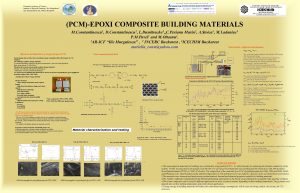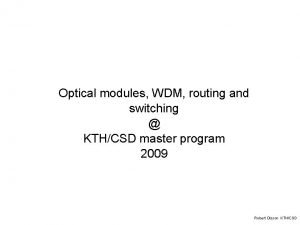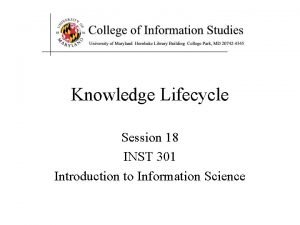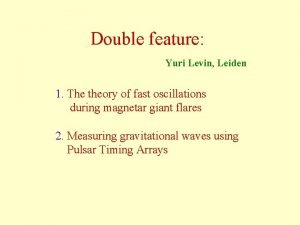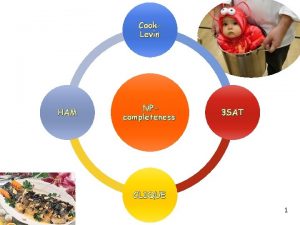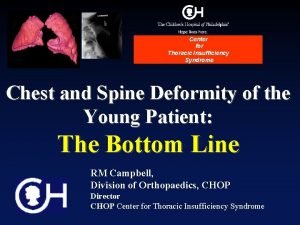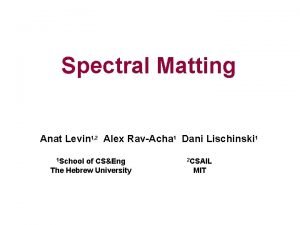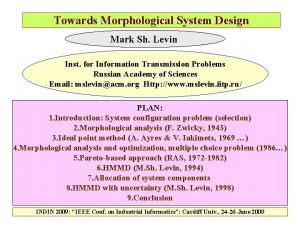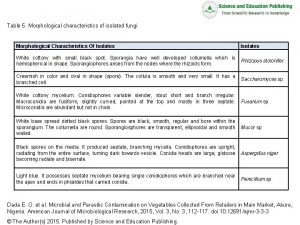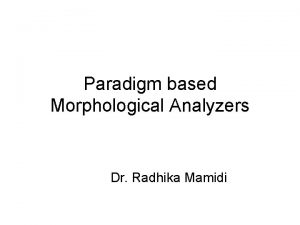Towards Morphological System Design Mark Sh Levin Inst




























- Slides: 28

Towards Morphological System Design Mark Sh. Levin Inst. for Information Transmission Problems Russian Academy of Sciences Email: mslevin@acm. org Http: //www. mslevin. iitp. ru/ PLAN: 1. Introduction: System configuration problem (selection) 2. Morphological analysis (F. Zwicky, 1943) 3. Ideal point method (A. Ayres & V. Iakimets, 1969 …) 4. Morphological analysis and optimization, multiple choice problem (1986…) 5. Pareto-based approach (RAS, 1972 -1982) 6. HMMD (M. Sh. Levin, 1994) 7. Allocation of system components 8. HMMD with uncertainty (M. Sh. Levin, 1998) 9. Conclusion INDIN 2009: “IEEE Conf. on Industrial Informatics”: Cardiff Univ. , 24 -26 June 2009

SYSTEM CONFIGURATION: SELECTION OF SYSTEM COMPONENTS System (parts/components): S = P(1) * … * P(i) * … * P(m) Configuration example: S 1 = X 12 * … * Xi 1 * … * Xm 3 P(1) X 11 … X 1 q 1 P(i) Xi 1 … Xiq 1 P(m) X m 1 … Xmq 1 This is about problem of representatives, multiple choice problem

BASIC REFERENCES FOR SYSTEM CONFIGURATION 1. M. Sh. Levin, Combinatorial Optimization in Systems Configuration Design, Automation & Remote Control (Springer), 70(3), pp. 519 -561, 2009. 2. Configuration design in AI (a set of papers and several workshops; versions of SAT problems)

MORPHOLOGICAL ANALYSIS (Zwicky, 1943) System Subsystem 1 A 1 Morphological class 1: |A 1| = m(1) Subsystem i . . . Ai Morphological class i: |Ai| = m(i) Subsystem n . . . An Morphological class n: |An| = m(n)

BASIC REFERENCES 1. F. Zwicky, Discovery Invention: Research Through the Morphological Analysis. New York, Mc. Millan, 1969. 2. R. Y. Ayres, Technological Forecasting and Long-Time Planning, New York, Mc. Graw-Hill, 1969. 3. J. C. Jones, Design Methods. 2 nd ed. , New York, Wiley, 1992. 4. T. Ritchey, Problem structuring using computer-aided morphological analysis J. of Operational Research Society, Vol. 57, no. 7, pp. 792 -801, 2006.

IDEAL POINT METHOD (Closeness to “IDEAL”) (Ayres, 1969) System Subsystem Y Subsystem X . . . X X 1 Subsystem Z . . . Y Z Y 1 ID 1 Z 1 Y 2 X 2 Z 2 IDi Y 3 X 3 Y 4 X 4 Z 3 IDn Y 5 “IDEAL” : X 1 * Y 3 * Z 3 (infeasible combination) S 1 = X 4 * Y 3 * Z 3 S 2 = X 2 * Y 5 * Z 1 (“IDEAL” , S 1 ) < (“IDEAL”, is a closeness (proximity) S 2 )

BASIC REFERENCES 1. R. Y. Ayres, Technological Forecasting and Long-Time Planning, New York, Mc. Graw-Hill, 1969. 2. Yu. A. Dubov, S. I. Travkin, V. N. Iakimets, Multicriteria Models for Building of System Choice Variants. Moscow, Nauka, 1986 (in Russian).

Multicriteria evaluation of feasible combinations & selection of Pareto -effective points (1972. . 1982) System Subsystem Y Subsystem X . . . X Y Y 1 X 2 X 3 Subsystem Z . . . Z Z 1 Y 2 Z 2 Y 3 Z 3 Y 4 X 4 Y 5 STEP 1. Generation of feasible combinations: S 1 = X 4 * Y 3 * Z 3 S 3 = X 4 * Y 2 * Z 3 S 2 = X 2 * Y 5 * Z 1 S 4 = X 4 * Y 1 * Z 3 STEP 2. Evaluation upon criteria STEP 3. Selection of Pareto-effective solutions

BASIC REFERENCES 1. S. V. Emeljanov, V. M. Ozernoy, O. I. Larichev, e al. , Choice of rational variants of technological mines upon multiple criteria, Mining J. , no. 5, 1972 (in Russian). 2. M. G. Gaft, N. N. Milovidov, V. I. Serov, E. D. Gusev, Decision making method for choice of rational configurations of cars. Problems&Methods of Decision Making in Organizational Management Systems. Moscow. Inst. for Systems Analysis, pp. 77 -82, 1982 (in Russian)

SELECTION OF SYSTEM COMPONENTS: MULTIPLE CHOICE PROBLEM . . . J 1 . . . Ji . . . Jm i | Ji | = qi , j = 1, … , qi max mi=1 qij=1 cij xij s. t. mi=1 qij=1 aij xij b qij=1 xij 1 , i = 1, … , m xij {0, 1}, i = 1, … , m , j = 1, … , qi Applications of multiple choice problem: (i)Software systems (ii)Hardware (ii)Improvement of communication systems

Integer nonlinear programming (modular design of series system from the viewpoint of reliability) (by Berman&Ashrafi) . . . J 1 . . . Ji i | Ji | = qi , j = 1, … , qi max mi=1 (1 - qij=1 ( 1 - pij xij ) ) s. t. mi=1 qij=1 dij xij b qij=1 xij 1 , i = 1, … , m xij {0, 1}, i = 1, … , m , j = 1, … , qi pij is reliability , dij is cost . . . Jm

BASIC REFERENCES FOR SYSTEM CONFIGURATION 1. M. R. Garey, D. S. Johnson, Computers and Intractability. Freeman, 1979. 2. S. Martello, P. Toth, Knapsack Problem, New York, Wiley, 1990. 3. H. Kellerer, U. Pferschy, D. Pisinger, Knapsack Problem. Springer, 2004. 4. O. Berman, N. Ashrafi, Optimization Models for Reliable Software System. IEEE Trans. Software Eng. , 19(11), pp. 1119 -1123, 1993. 5. V. Poladian et. al. , Task-Base adaptation for ubiquitous computing. IEEE Trans. SMC, 36(3), pp. 328 -340, 2006. 6. M. Sh. Levin, A. V. Safonov, Design and redesign of configuration for facility in communication network. Inform. Technol. & Comp. Systems, Issue 4, pp. 63 -73, 2006 (in Russian) 7. M. Sh. Levin, Combinatorial Optimization in Systems Configuration Design, Autom. &Rem. Control (Springer), 70(3), pp. 519 -561, 2009.

MORPHOLOGICAL CLIQUE (or multipartite clique) Edges (compatibility) PART 2 Vertices (design alternatives) PART 1 NOTE: about k-matching PART 3

Hierarchical Morphological Multicriteria Design (HMMD) S=X*Y*Z S 1=X 1*Y 4*Z 3 X Y Z X 1(2) Y 1(3) Z 1(1) X 2(1) Y 2(1) Z 2(1) X 3(1) Y 3(2) Z 3(2) Y 4(3)

Concentric presentation of morphological clique with estimates of compatibility Y 4 Y 1 3 2 Y 3 3 Y 2 2 X 1 X 3, X 2 Z 1, Z 2 2 Z 3 3 1

Two-criteria space of quality for resultant combinations Quality of elements Ideal Point Pareto-effective points (combinations) Quality of compatibility

Discrete space of composite system quality (by components) <3, 0, 0> The Ideal Point <2, 1, 0> <2, 0, 1> <1, 2, 0> <1, 1, 1> <0, 3, 0> <1, 0, 2> <0, 2, 1> S 1 <0, 1, 2 > <0, 0, 3 > The Worst Point

Discrete space of composite system quality (by components, by compatibility) Ideal Point w=3 N(S 1) w=2 w=1 THIS IS THE SPACE OF VECTORS: N(S) = ( w (S) ; n 1(S) , n 2(S) , n 3(S) ) where w (S) is the estimate of compatibility (e. g. , minimum of pairwise compatibility estimates) & n 1 (S) is the number of components at the 1 st quality level, etc.

Two types of solving schemes 1. Enumerative directed heuristic: analysis and checking since the best point. 2. Dynamic programming methods: extension of the method for knapsack problem or multiple choice problem.

Illustration for HMMD (based on morphological clique problem) S=X*Y*Z S 1=X 2*Y 3*Z 2 S 2=X 1*Y 2*Z 1 X=A*B*C*D X 1=A 1*B 2*C 4*D 3 X 2=A 3*B 4*C 2*D 1 Y Compatibility for X, Y, Z Compatibility for A, B, C, D A 1 A 2 A 3 B B 1 B 2 B 3 B 4 C C 1 C 2 C 3 C 4 C 5 D 1=I 1*J 1 D 2=I 1*J 2 D 3=I 3*J 4 I I 1 I 2 I 3 Compatibility for I, J Z 1=P 2*Q 3*U 1*V 5 Z 2=P 1*Q 2*U 3*V 1 Y 2 Y 3 D=I*J A Z=P*Q*U*V P J J 1 J 2 J 3 J 4 P 1 P 2 P 3 Q Q 1 Q 2 Q 3 Q 4 V U U 1 U 2 U 3 Compatibility for P, Q, U, V V 1 V 2 V 3 V 4 V 5 V 6

BASIC REFERENCES 1. M. Sh. Levin, Combinatorial Engineering of Decomposable Systems. Boston/Dordrecht, Kluwer, 1998. 2. M. Sh. Levin, Composite Systems Decisions, London/New York, Springer, 2006. 3. M. Sh. Levin, Papers 4. M. Sh. Levin, Educational Courses (& Research with Students): “System Design” (recent course in Moscow Inst. of Physics &Technology, 2004… 2008), etc.

ASSIGNMENT/ALLOCATION Allocation (assignment, matching, location): a Set of elements (e. g. , personnel, facilities) b 1 MAPPING 2 3 c d 4 e 5 f 6 7 g 8 h BIPARTITE GRAPH Positions (locations, sites)

ASSIGNMENT as morphology Positions (locations, sites) a b c d . . . Candidates for position a Candidates for position b Candidates for position c Candidates for position d . . .

BASIC REFERENCES FOR ASSIGNMENT/ALLOCATION 1. M. R. Garey, D. S. Johnson, Computers and Intractability. New York, Freeman, 1979. 2. E. Cela, The Quadratic Assignment Problem. Kluwer, 1998. 3. P. M. Pardalos, H. Wolkowicz, (Eds. ), Quadratic Assignment and Related Problems, Providence, AMS, 1994. 4. M. Sh. Levin, Combinatorial Engineering of Decomposable Systems. Kluwer, 1998. 5. M. Sh. Levin, Combinatorial optimization in system configuration design. Automation & Remote (Springer), 70(3), pp. 519 -561, 2009.

Hierarchical Morphological Multicriteria Design (HMMD) with Uncertainty: 1. Probabilistic estimates 2. Fuzzy estimates 3. etc. A. Estimates of DAs: (0)deterministic (1)probabilistic (2)fuzzy estimates (e. g. , interval estimates) B. Estimates of compatibility: (0)deterministic (1)probabilistic (1)fuzzy estimates (e. g. , interval estimates) RESULT: 9 CASES

Hierarchical Morphological Multicriteria Design (HMMD) with Uncertainty METHODOLOGICAL APPROACHES: Case 1 (Basic): DAs: deterministic (aggregated) estimates Compatibility: deterministic (aggregated) estimates Case 2. DAs: deterministic (aggregated) estimates Compatibility: fuzzy estimates Case 3. DAs: fuzzy estimates Compatibility: deterministic (aggregated) estimates Case 4. DAs: fuzzy estimates Compatibility: fuzzy estimates

Two-criteria space of quality for resultant combinations Quality of elements Ideal Point Case 3 Case 1 Case 2 Case 4 Quality of compatibility

BASIC REFERENCES 1. M. Sh. Levin, Combinatorial Engineering of Decomposable systems, Kluwer, 1998. 2. M. Sh. Levin, Papers in progress
 Aafbr
Aafbr Rubiterm
Rubiterm Hresca inst
Hresca inst Parshvanath charitable trusts a.p.shah inst.of tech
Parshvanath charitable trusts a.p.shah inst.of tech Inst154
Inst154 Packing instruction 620
Packing instruction 620 Inst-154
Inst-154 Inst
Inst Royal inst
Royal inst Inst 301
Inst 301 Inst eecs
Inst eecs Kurt levin
Kurt levin Vladimir levin
Vladimir levin Ana karenina obnova
Ana karenina obnova Campo vital kurt lewin
Campo vital kurt lewin Hal levin
Hal levin Pulsar timing
Pulsar timing Henry m levin
Henry m levin Levin ham
Levin ham Kurt levin
Kurt levin Estelle levin
Estelle levin Levin ng tube
Levin ng tube Jarcho-levin syndrome pictures
Jarcho-levin syndrome pictures Ravacha
Ravacha Levin kurt
Levin kurt Teoria del campo
Teoria del campo Jarcho levin syndrome icd 10
Jarcho levin syndrome icd 10 Dr becheru
Dr becheru Sonda nasoyeyunal
Sonda nasoyeyunal


